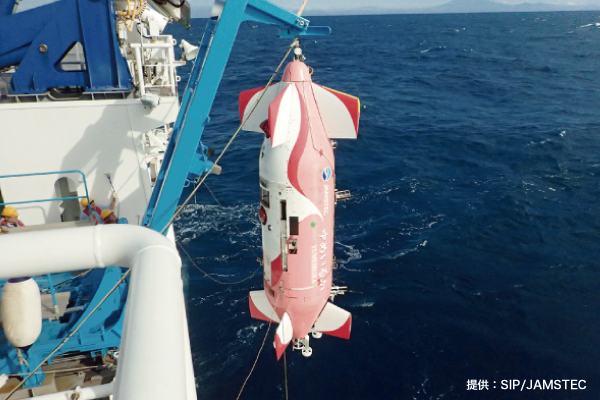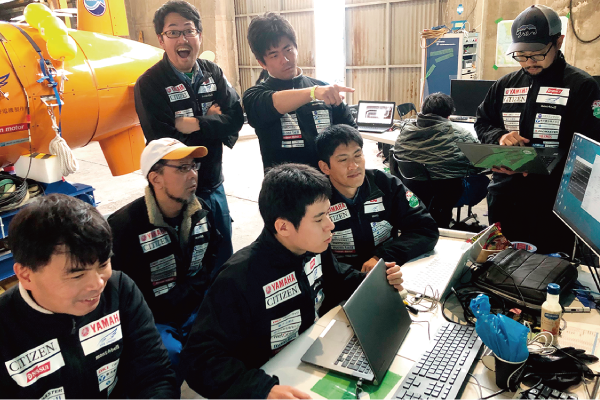- PROJECT MOTHER
- someone
- Information for Middle and High School Researchers
Pursuing the true view of the deep sea, as seen by unmanned probes
2020.10.10

Japan Agency for Marine-Earth Science and Technology
Research Platform Operations and Development Division
Marine Robotics Development and Implementation Group
chief engineer Tatsuya Aso three

▲ In the room monitoring AUVs during the finals of the Shell Ocean Discovery XPRIZE in Greece. Mr. Aso is in the back row in the center, looking this way. (Courtesy of Team KUROSHIO)
Water pressure that could crush a metal bat, water temperatures below 10 degrees Celsius, and darkness that makes it impossible to see even an inch ahead. The deep sea is a mysterious environment at the bottom of the ocean, and it is a very harsh environment for human beings to face in the flesh. In order to investigate such "the last frontier on earth," human beings are developing technologies for underwater exploration.
The bottom of the sea still unseen
The oceans occupy 2/3 of the Earth's surface, with an average depth of 3,800 meters. Most of this vast environment is still unknown, and the topographic map of the seafloor is no clearer than that of the moon, which is about 380,000 km away from the earth. However, through repeated investigations, valuable seafloor resources such as methane hydrate, hydrothermal deposits, and rare earth mud have been discovered. Furthermore, new parts of the Earth that have not been visible until now are being revealed, such as predictions of earthquakes and hints for understanding the formation of the Earth.
Underwater explorers have contributed to revealing this new aspect of the deep sea, and have introduced the world to the fascinating world of the deep sea. JAMSTEC, which is conducting research on the "Ocean and Earth," is trying to reveal a world shrouded in mystery through the use of underwater explorers.
Underwater probe shines light on the deep sea
Currently, JAMSTEC is utilizing three types of underwater exploration platforms. Manned submersible research vessels, which are operated by a person on board to conduct surveys to their destinations. An unmanned ROV (Remotely Operated Vehicle), which is operated remotely from the mother ship via cable to conduct surveys. And then there is the AUV (Autonomous underwater vehicle), which moves to the survey area based on a program embedded in a computer and conducts the survey autonomously according to the site conditions. The deep sea is a very large area, and it would take an enormous amount of time to conduct surveys by hand. That is why we need a new survey technology like the AUV. This is why we need new survey technologies such as AUVs," says Tatsuya Aso, who is developing the state-of-the-art Yume-Iruka AUV.
The Yume-Iruka is equipped with a rudder not only in the back but also in the front, enabling it to navigate on a slope while keeping the aircraft level. This enables the acquisition of highly accurate data. Mr. Aso is working on optimizing the motion of the aircraft to improve the accuracy of the bathymetry data.

The Yume-i-Iruka heading for undersea research (photo courtesy of SIP/JAMSTEC)
The important thing is to take one step at a time
In December 2015, it was announced that the international competition "Shell Ocean Discovery XPRIZE" would be held with the aim of surveying the seafloor topography equivalent to 10,000 Tokyo Domes in 24 hours using unmanned exploration robots. From Japan, eight organizations and companies, including JAMSTEC, joined forces to participate as "Team KUROSHIO. The Japanese team, which integrated underwater probe technologies developed up to now, such as the Yume-Iruka, and utilized the AUV developed by the team, successfully conducted an ultra-wide-area, ultra-fast exploration of the seafloor, and was awarded second place in the world.
Until now, human operators have had to travel to the research area in order to conduct surveys. However, the XPRIZE has given birth to a new technology that allows robots to go out alone from the shore to conduct surveys. Although there are still few achievements, I believe that this will eventually lead to the development of a system in which an underwater probe can automatically survey Japan's exclusive economic zone," says Aso. The day may not be far off when the technology for developing underwater probes will reveal the deep sea, where much of the environment still remains unexplored.
(Text by Yuzen Kodama)
Team KUROSHIO special site
